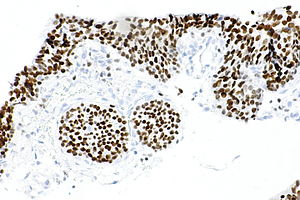Difference between revisions of "GATA3"
Jump to navigation
Jump to search
| Line 27: | Line 27: | ||
*Pheochromocytoma (~70%) vs adrenocortical carcinoma (<10%<ref name=pmid2837449>{{Cite journal | last1 = Perrino | first1 = CM. | last2 = Ho | first2 = A. | last3 = Dall | first3 = CP. | last4 = Zynger | first4 = DL. | title = Utility of GATA3 in the differential diagnosis of pheochromocytoma. | journal = Histopathology | volume = 71 | issue = 3 | pages = 475-479 | month = Sep | year = 2017 | doi = 10.1111/his.13229 | PMID = 28374498 }}</ref>). | *Pheochromocytoma (~70%) vs adrenocortical carcinoma (<10%<ref name=pmid2837449>{{Cite journal | last1 = Perrino | first1 = CM. | last2 = Ho | first2 = A. | last3 = Dall | first3 = CP. | last4 = Zynger | first4 = DL. | title = Utility of GATA3 in the differential diagnosis of pheochromocytoma. | journal = Histopathology | volume = 71 | issue = 3 | pages = 475-479 | month = Sep | year = 2017 | doi = 10.1111/his.13229 | PMID = 28374498 }}</ref>). | ||
*[[Brenner tumour]]s and [[Walthard cell rest]]s.<ref name=pmid25281026>{{Cite journal | last1 = Roma | first1 = AA. | last2 = Masand | first2 = RP. | title = Ovarian Brenner tumors and Walthard nests: a histologic and immunohistochemical study. | journal = Hum Pathol | volume = 45 | issue = 12 | pages = 2417-22 | month = Dec | year = 2014 | doi = 10.1016/j.humpath.2014.08.003 | PMID = 25281026 }}</ref> | *[[Brenner tumour]]s and [[Walthard cell rest]]s.<ref name=pmid25281026>{{Cite journal | last1 = Roma | first1 = AA. | last2 = Masand | first2 = RP. | title = Ovarian Brenner tumors and Walthard nests: a histologic and immunohistochemical study. | journal = Hum Pathol | volume = 45 | issue = 12 | pages = 2417-22 | month = Dec | year = 2014 | doi = 10.1016/j.humpath.2014.08.003 | PMID = 25281026 }}</ref> | ||
*[[Malignant mesothelioma]]s (58%<ref name=pmid24145643 | *[[Malignant mesothelioma]]s (58%<ref name=pmid24145643/>). | ||
===Images=== | ===Images=== | ||
Revision as of 20:01, 7 July 2020
| GATA3 | |
|---|---|
| Immunostain in short | |
 GATA3 staining in benign urothelium. | |
| Similar stains | thrombomodulin |
| Use | bladder versus prostate, bladder versus SCC |
| Subspeciality | Genitourinary pathology, Breast pathology |
| Normal staining pattern | nuclear |
| Positive | urothelial carcinoma, invasive ductal carcinoma of the breast, lobular breast carcinoma |
| Negative | prostatic carcinoma, squamous cell carcinoma of the lung |
GATA3 an immunostain that is increasingly used in genitourinary pathology.
Positive
- Urothelial carcinoma.[1]
- Breast carcinoma - more sensitive than GCDFP-15.[2]
- Chromophobe renal cell carcinoma ~50% of cases.[2]
- Trophoblastic tumours +ve.[4] including choriocarcinoma.[5]
- Parathyroid - parathyroid hyperplasia, parathyroid adenoma, parathyroid carcinoma.[6]
- Salivary gland tumours [7]
- Pheochromocytoma (~70%) vs adrenocortical carcinoma (<10%[8]).
- Brenner tumours and Walthard cell rests.[9]
- Malignant mesotheliomas (58%[2]).
Images
Negative
- Prostate carcinoma.
- Positive in benign prostate glands with radiation atypia.[10]
- Squamous cell carcinoma of the lung.[1]
See also
References
- ↑ 1.0 1.1 1.2 Chang A, Amin A, Gabrielson E, et al. (October 2012). "Utility of GATA3 immunohistochemistry in differentiating urothelial carcinoma from prostate adenocarcinoma and squamous cell carcinomas of the uterine cervix, anus, and lung". Am. J. Surg. Pathol. 36 (10): 1472–6. doi:10.1097/PAS.0b013e318260cde7. PMC 3444740. PMID 22982890. https://www.ncbi.nlm.nih.gov/pmc/articles/PMC3444740/.
- ↑ 2.0 2.1 2.2 Miettinen, M.; McCue, PA.; Sarlomo-Rikala, M.; Rys, J.; Czapiewski, P.; Wazny, K.; Langfort, R.; Waloszczyk, P. et al. (Jan 2014). "GATA3: a multispecific but potentially useful marker in surgical pathology: a systematic analysis of 2500 epithelial and nonepithelial tumors.". Am J Surg Pathol 38 (1): 13-22. doi:10.1097/PAS.0b013e3182a0218f. PMID 24145643.
- ↑ Ellis, CL.; Chang, AG.; Cimino-Mathews, A.; Argani, P.; Youssef, RF.; Kapur, P.; Montgomery, EA.; Epstein, JI. (Nov 2013). "GATA-3 immunohistochemistry in the differential diagnosis of adenocarcinoma of the urinary bladder.". Am J Surg Pathol 37 (11): 1756-60. doi:10.1097/PAS.0b013e31829cdba7. PMID 24061521.
- ↑ Mirkovic, J.; Elias, K.; Drapkin, R.; Barletta, JA.; Quade, B.; Hirsch, MS. (Nov 2015). "GATA3 expression in gestational trophoblastic tissues and tumours.". Histopathology 67 (5): 636-44. doi:10.1111/his.12681. PMID 25753145.
- ↑ Osman, H.; Cheng, L.; Ulbright, TM.; Idrees, MT. (Feb 2016). "The utility of CDX2, GATA3, and DOG1 in the diagnosis of testicular neoplasms: an immunohistochemical study of 109 cases.". Hum Pathol 48: 18-24. doi:10.1016/j.humpath.2015.09.028. PMID 26772394.
- ↑ Ordóñez, NG.. "Value of GATA3 immunostaining in the diagnosis of parathyroid tumors.". Appl Immunohistochem Mol Morphol 22 (10): 756-61. doi:10.1097/PAI.0000000000000007. PMID 25046229.
- ↑ Schwartz, LE.; Begum, S.; Westra, WH.; Bishop, JA. (Dec 2013). "GATA3 immunohistochemical expression in salivary gland neoplasms.". Head Neck Pathol 7 (4): 311-5. doi:10.1007/s12105-013-0442-3. PMID 23604756.
- ↑ Perrino, CM.; Ho, A.; Dall, CP.; Zynger, DL. (Sep 2017). "Utility of GATA3 in the differential diagnosis of pheochromocytoma.". Histopathology 71 (3): 475-479. doi:10.1111/his.13229. PMID 28374498.
- ↑ Roma, AA.; Masand, RP. (Dec 2014). "Ovarian Brenner tumors and Walthard nests: a histologic and immunohistochemical study.". Hum Pathol 45 (12): 2417-22. doi:10.1016/j.humpath.2014.08.003. PMID 25281026.
- ↑ "GATA3 expression in benign prostate glands with radiation atypia: a diagnostic pitfall". Histopathology 71 (1): 150–155. July 2017. doi:10.1111/his.13214. PMID 28316088.